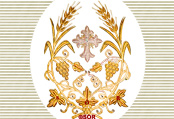|
OO Meetings
 Dec-2005 Dec-2005
 Oct-2004 Oct-2004
 Oct-2003 Oct-2003
 Dec-2002 Dec-2002
 Mar-2001 Mar-2001
 May-2000 May-2000
 Feb-1999 Feb-1999
 Mar-1998 Mar-1998
Other Dialogues
 OO-Anglican: Nov-2003 OO-Anglican: Nov-2003
 OO-RC: Jun-2003 OO-RC: Jun-2003
 OO-Anglican: Nov-2002 OO-Anglican: Nov-2002
 Russian Orth: Sep-2001 Russian Orth: Sep-2001
 Pope at Damascus: May-2001 Pope at Damascus: May-2001
 OO-RC: Jun-2000 OO-RC: Jun-2000
 Syriac Consultation: Jul-1997 Syriac Consultation: Jul-1997
 Easter Date: Mar-1997 Easter Date: Mar-1997
 OO-SOC (on Marriage): Jan-1994 OO-SOC (on Marriage): Jan-1994
 Melkite-SOC: Nov-1991 Melkite-SOC: Nov-1991
 RC-SOC Declarations: 1971 & 1984 RC-SOC Declarations: 1971 & 1984
|
|
A Synodal and Patriarchal Letter.
To All Our Children, Protected by God, of the Holy See of Antioch:
Beloved:
You must have heard of the continuous efforts for decades by our Church
with the sister Syrian Orthodox Church to foster a better knowledge and
understanding of both Churches, whether on the dogmatic or pastoral level.
These attempts are nothing but a natural expression that the Orthodox
Churches, and especially those within the Holy See of Antioch, are called
to articulate the will of the Lord that all may be obey, just as the Son
is One with the Heavenly Father (John 10:30).
It is our duty and that of our brothers in the Syrian Orthodox Church
to witness to Christ in our Eastern region where He was born, preached,
suffered, was buried and rose from the dead, ascended into Heaven, and
sent down His Holy and Life Giving Spirit upon His holy Apostles.
All the meetings, the fellowship, the oral and written declarations meant
that we belong to One Faith even though history had manifested our division
more than the aspects of our unity.
All this has called upon our Holy Synod of Antioch to bear witness to
the progress of our Church in the See of Antioch towards unity that preserves
for each Church its authentic Oriental heritage whereby the one Antiochian
Church benefits from its sister Church and is enriched in its traditions,
literature and holy rituals.
Every endeavor and pursuit in the direction of the coming together of
the two Churches is based on the conviction that this orientation is from
the Holy Spirit, and it will give the Eastern Orthodox image more light
and radiance, that it has lacked for centuries before.
Having recognized the efforts done in the direction of unity between
the two Churches, and being convinced that this direction was inspired
by the Holy Spirit and projects a radiant image of Eastern Christianity
overshadowed during centuries, the Holy Synod of the Church of Antioch
saw the need to give a concrete expression of the close fellowship between
the two Churches, the Syrian Orthodox Church and the Eastern Orthodox
for the edification of their faithful.
Thus, the following decisions were taken:
- We affirm the total and mutual respect of the spirituality, heritage
and Holy Fathers of both Churches. The integrity of both the Byzantine
and Syriac liturgies is to be preserved.
- The heritage of the Fathers in both Churches and their traditions
as a whole should be integrated into Christian education curricula and
theological studies. Exchanges of professors and students are to be
enhanced.
- Both Churches shall refrain from accepting any faithful from accepting
any faithful from one Church into the membership of the other, irrespective
of all motivations or reasons.
- Meetings between the two Churches, at the level of their Synods, according
to the will of the two Churches, will be held whenever the need arises.
- Every Church will remain the reference and authority for its faithful,
pertaining to matters of personal status (marriage, divorce, adoption,
etc.).
- If bishops of the two Churches participate at a holy baptism or funeral
service, the one belonging to the Church of the baptized or deceased
will preside. In case of a holy matrimony service, the bishop of the
bridegroom's Church will preside.
- The above mentioned is not applicable to the concelebration in the
Divine Liturgy.
- What applies to bishops equally applies to the priests of both Churches.
- In localities where there is only one priest, from either Church,
he will celebrate services for the faithful of both Churches, including
the Divine Liturgy, pastoral duties, and holy matrimony. He will keep
an independent record for each Church and transmit that of the sister
Church to its authorities.
- If two priests of the two Churches happen to be in a locality where
there is only one Church, they take turns in making use of its facilities.
- If a bishop from one Church and a priest from the sister Church happen
to concelebrate a service, the first will preside even when it is the
priest's parish.
- Ordinations into the holy orders are performed by the authorities
of each Church for its own members. It would be advisable to invite
the faithful of the sister Church to attend.
- Godfathers, godmothers (in baptism) and witnesses in holy matrimony
can be chosen from the members of the sister Church.
- Both Churches will exchange visits and will co-operate in the various
areas of social, cultural and educational work.
We ask God's help to continue strengthening our relations with the sister
Church, and with other Churches, so that we all become one community
under one Shepherd.
Damascus
12 November 1991
Patriarch Ignatios IV
of the Greek Antiochian Church
Patriarch Ignatius Zakka Iwas
of the Syrian Orthodox Church of Antioch
|
|
|

